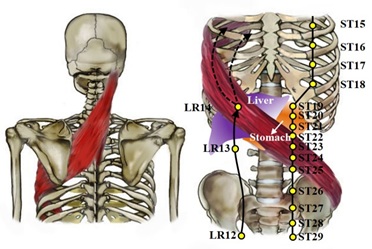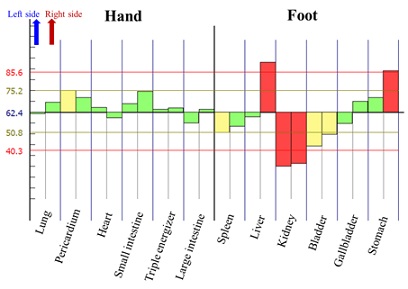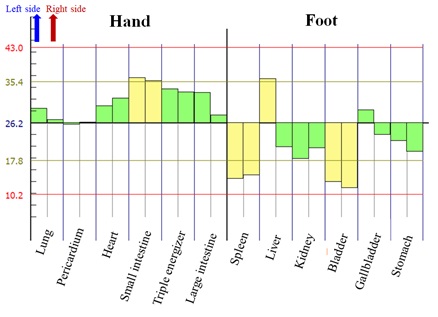
The Spinal is a Key to Treat Diseases, the Interaction between Meridians and Fasciae
*Corresponding Author(s):
Jih-Huah WuDepartment Of Biomedical Engineering, Ming Chuan University, Taoyuan, Taiwan
Tel:+886 0335070013951,
Email:wujh@mail.mcu.edu.tw
Abstract
The connection between fascia and acupoints has been suggested for many years. Recently, new conceptions revealed interesting hypothesis and experimental results regarding the connection between meridians and fascia tissue. The relationships of fascia problem and meridians are discussed rarely, however, the unbalanced structure of human being affect the meridian conduction. It cause the fascia tension and change the 12 meridian values, then cause some relative symptoms, even diseases. Finally, it affect the efficiency of any treatment. In this article, two cases that reveal the relationships of fascia and meridian are presented.
Keywords
Fascia; Meridians; Spinal
To Keep the meridians in balance situation is a key role to maintain health for people. In TCM, before treating the patients with needle acupuncture or other therapy, the 12 meridian values should be measured in advance with pulse diagnosis to decide which meridians and acupoints should be chosen. From my experience, sometimes the unbalanced meridian value is caused by the unbalanced structure of human body, it means some fasciae are stretched out, some are squeezed. Fascia is a fibro-elastic tissue [1] that wraps most structures and connects specific muscles in straight, angling and spiraling patterns in the human body. And fascia system include several anatomical areas, such as partial Spiral Line are overlapped with liver and stomach meridians. Based on the anatomical areas of the fascia spiral, the fascia tissue involved the neck, ribs, abdominal, thigh, calf, sole of the foot and buttocks area. Therefore, the stomach symptoms could be occurred by abnormal stretch or tighten of abdominal fascia tissue. Besides, the liver and stomach meridians pass through the organs of liver and stomach as shown in figure 1. Thus, the meridians or symptoms of liver and stomach were affected by the Spinal Line fascia.
 Figure 1: Schematics for the anatomical areas of spiral fascia, liver and stomach meridians in TCM were illustrated [2].
Figure 1: Schematics for the anatomical areas of spiral fascia, liver and stomach meridians in TCM were illustrated [2].
Many clinical researches revealed interesting hypothesis and experimental results for the connection between meridians and connective tissue. In 1950, the electrical resistance on the skin was investigated by Yoshio Nakatani [3,4]. The electrical conductance at acupoints along large intestine and pericardium meridians are increased [5,6]. Low resistance in the meridians was due to the relatively higher content of interstitial fluids [7]. The signal transmission along meridians may be determined by the flow of tissue fluid in the connective tissue and involve mast cell degranulation [8]. The hypothesis that meridian could literally describe the nature of the physical substrate as the silk-like fascial tissue of the body was proposed [9]. 80% correspondence between the aupoints and location of intermuscular/ intramuscular connective tissue planes in postmortem tissue sections was found [10]. Moreover, the distribution of the rebuilt connective tissue string was similar to the meridians line of upper limbs after compared with large intestine meridian and lung meridian by magnetic resonance images [11]. These fascial strings were close to virtual meridians in Traditional Chinese Medicine (TCM). This finding provided a preliminary explanation of the anatomical and physiological basis for the connection with tissue flow, connective tissue and the meridians.
In this article, 2 cases (1 male and 1 female) with scoliosis were included to evaluate the connection of meridians and spiral fascia. Scoliosis is usually "S" or "C" shaped for a person's spine that could influence the spiral fascia in daily life. Moreover, scoliosis can affect the spiral fascia and cause an impact on the intermuscular/ intramuscular connective tissue. The spiral fascia has been identified as part of a double helix structure that probably plays a significant role in the support of the spine and torso [2,12]. To evaluate the relationship between meridians and spiral fascia, two cases were measured by Meridian Energy Analysis Device (ME-100, manufactured by Medpex lnc. Taiwan). 12 meridians involved lung, pericardium, heart, small intestine, triple energizer, large intestine, spleen, liver, kidney, bladder, gallbladder and stomach. According to the instruction, when the current was less than 50 μA, it represented that the relative meridian was “deficiency” syndrome. When the current was greater than 90 μA, it represented that the relative meridian was “excess” syndrome. The acupoints measurement from hand and foot were most associated with the internal organs in the body and the energetic level of the meridians.
In case 1 (58 years old, female), who injured on the right shoulder and accompanied with stomach pain symptoms. The right side of liver and stomach meridians were higher than normal state as shown in figure 2. Based on the anatomical areas of the fascia spiral, as shown in figure 1, the stomach symptoms could be occurred by abnormal stretch or tighten of abdominal fascia tissue. Besides, the liver and stomach meridians pass through the organs of liver and stomach as shown in figure 1. The meridians channel interacting and mutually supportive influences a person’s health with the balance in human body. The meridian measurement result is consistent with the anatomical areas of spiral fascia.
 Figure 2: The spiral fascia affects the liver (right side) and stomach meridians (right side) for case 1 (green color: normal state; yellow color: requires attention; red color: warning).
Figure 2: The spiral fascia affects the liver (right side) and stomach meridians (right side) for case 1 (green color: normal state; yellow color: requires attention; red color: warning).
In case 2 (59 years old, male), the left side of liver meridians was higher than normal state as shown in figure 3. Abnormal fascia spiral can be affected by the scoliosis directly. R. Roaf found the anterior longitudinal ligament has been longer than the sum of the corresponding interspinous in all the scoliotic spines [12]. In the recent years, L. W. Ferguson indicated that the progressive contraction of fascial spiral is a unifying factor in the development of idiopathic scoliosis, when combined with lowered intrinsic resistance to distortion due to ligamentous laxity [13]. This finding can be regarded as the therapeutic significance in clinical. The measurement suggested that the progressive contraction of fascial spiral occurred as a result in a higher liver meridian in this case.
 Figure 3: The spiral fascia affects the liver meridians (left side) for case 2 (green color: normal state; yellow color: requires attention; red color: warning).
Figure 3: The spiral fascia affects the liver meridians (left side) for case 2 (green color: normal state; yellow color: requires attention; red color: warning).
Scoliosis is usually an S- or C-shaped spine that can influence the spiral fascia in daily life. Moreover, scoliosis can affect the spiral fascia and cause an impact on the intermuscular/intramuscular connective tissue. The spiral fascia is part of a double helix structure that probably plays a significant role in the support of the spine and torso [2]. Some studies indicated that the development of a scoliotic spine is dependent on the ligament condition. R. Roaf found that the anterior longitudinal ligament was longer than the sum of the corresponding interspinous ligament in all the scoliotic spines [12]. In the recent years, L.W. Ferguson indicated that the progressive contraction of the fascial spiral is a unifying factor in the development of idiopathic scoliosis, when combined with lowered intrinsic resistance to distortion due to ligamentous laxity [10]. This means that the abnormal spiral fascial stretch or tension, ligament length, and meridian conduction can directly affect the scoliosis patients.
The unbalanced meridian values were caused by the unbalanced structure of the human body. The meridians measurement suggested that the asymmetric spine and progressive contraction of the fascial spiral could affect the unhealthy organs and even cause the pain symptoms. To achieve the best treatment of diseases, I suggest that the spinal should be corrected simultaneously.
References
- Findley T, Chaudhry H, Stecco A, Roman M (2012) Fascia research - A narrative review. Journal of Bodywork & Movement Therapies 16: 67-75.
- Myers T (2014) Anatomy Trains. Elsevier, London, UK.
- Nakatani Y (1972) A guide for application of Ryodoraku autonomous nerve regulatory therapy. Chan’s Books & Products, USA.
- Larsen AP, Fasa DC (2022) Ryodoraku History and Research. Disponível na Internet em, Japan.
- Becker RO, Reichmanis M, Marino A, Spadaro JA (1976) Electrophysiological correlates of acupuncture points and meridians. Psychoenergetic Systems 1: 105-112.
- Cohen M, Voumard P, Birch S, Jenvey S, Cosic I (1995) Low resistance pathways along acupuncture meridians have dynamic characteristics. Biomedical Engineering—Applications, Basis and Communication 7: 137-142.
- Yang W (2008) Investigation of the Lower Resistance Meridian IV. Speculation on the Physiological Functions of Acupuncture Meridians. Journal of Beijing Normal University (Natural Science)/Acta Scientiarum Naturalium Universitatis Pekinensis 44: 281-287.
- Zhang D, Yao W, Dung GH, Yang J, Schwarz W, et al. (2009) A fluid mechanics model of tissue fluid flow in limb connective tissue – A mechanism of acupuncture signal transmission, J Hydrodynamics 21: 675-684.
- Shaw V, Aland C (2013) Meridians under the skin, Journal of the Acupuncture Association of Chartered Physiotherapists 2013: 75-81.
- Langevin HM, Yandow JA. Relationship of acupuncture points and meridians to connective tissue planes. Anat Record (New Anat) 269: 257-265.
- Bai Y, Yuan L, Huang Y, Wang C, Wang J, et al. (2012) From the anatomical discovery of meridians and collaterals to fasciaology theory. In: Soh K, Kang K, Harrison D, (eds.). The Primo Vascular System: Its Role in Cancer and Regeneration. Springer, USA.
- Roaf R (1966) The basic anatomy of scoliosis. J Bone Joint Surg 48: 786-792.
- Ferguson LW (2017) Adolescent idiopathic scoliosis: The Tethered Spine III: Is fascial spiral the key? Journal of Bodywork & Movement Therapies 21: 948-971.
Citation: Wu J-H (2023) The Spinal is a Key to Treat Diseases, the Interaction between Meridians and Fasciae. J Altern Complement Integr Med 9: 315.
Copyright: © 2023 Jih-Huah Wu, et al. This is an open-access article distributed under the terms of the Creative Commons Attribution License, which permits unrestricted use, distribution, and reproduction in any medium, provided the original author and source are credited.

